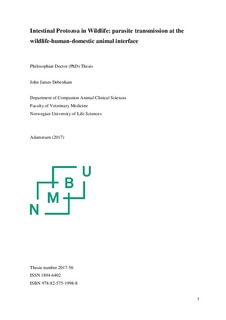| dc.contributor.advisor | Robertson, Lucy Jane | |
| dc.contributor.advisor | Midtgaard, Fred | |
| dc.contributor.advisor | Skancke, Ellen | |
| dc.contributor.author | Debenham, John James | |
| dc.date.accessioned | 2017-07-05T08:18:04Z | |
| dc.date.available | 2017-07-05T08:18:04Z | |
| dc.date.issued | 2017 | |
| dc.identifier.isbn | 978-82-575-1998-8 | |
| dc.identifier.issn | 1894-6402 | |
| dc.identifier.uri | http://hdl.handle.net/11250/2447847 | |
| dc.description.abstract | The interfaces between humans, wild animals, and domestic animals are changing. This process is driven by a multitude of factors, including changes in land use, habitat loss and fragmentation, climate change, ecotourism, commercial use of bush-meat, and a massive growth in the human population. It is said that this process is leading to the emergence of new infectious diseases, and that most of these have their origins in wildlife. Somewhat overlooked, is the importance that this may have on wildlife conservation, as previously isolated wild populations are now exposed to the pathogens of humans and their animals.
Giardia, Cryptosporidium, Entamoeba, and Eimeria are genera of protozoan parasites that cause widespread human and animal disease. Giardia and Cryptosporidium, in particular, contain species that are able to infect a wide range of host species, and thus are good candidates for crossing the human-domestic animal-wildlife boundaries. Despite this, the role of these parasites in wildlife populations remains largely unknown, both in respect to the impact they may have on wildlife conservation, and also whether wildlife populations may act as reservoirs for human and domestic animal disease.
In this thesis I present a number of studies that investigate the epidemiology of these protozoa in wildlife. Due to their close taxonomic relationship to humans, and thus the inferred susceptibility to similar pathogens, a large focus was on nonhuman primates (NHPs). Nonhuman primates were found to be infected with the same types of Giardia as humans, however, there was a large variation in prevalence between populations. In contrast, whereas Entamoeba was a common parasite in NHPs with close human contact, no human pathogenic species were detected. Cryptosporidium was not found to be a common pathogen in the NHPs studied. | nb_NO |
| dc.description.abstract | Forholdet mellom mennesker, ville dyr og husdyr er i endring. Denne prosessen drives frem av en rekke faktorer, blant annet endringer i bruk av landområder, tap av habitat og habitatfragmentering, klimaendringer, økoturisme, kommersiell utnyttelse av skogsdyr for kjøtt, og en massiv vekst i den menneskelige befolkningen. Det sies at denne prosessen fører til fremveksten av nye smittsomme sykdommer, og at de fleste av disse har sin opprinnelse i ville dyr. På den andre siden kan dette også være viktig for bevaring av dyreliv, da tidligere isolerte villdyrpopulasjoner nå er utsatt for patogener fra mennesker og deres husdyr.
Giardia, Cryptosporidium, Entamoeba og Eimeria er parasittiske protozooer som forårsaker alvorlig sykdom hos både mennesker og dyr i store deler av verden. Giardia og Cryptosporidium inkluderer arter som er i stand til å infisere et bredt spekter av verter, og er dermed gode kandidater til å kunne krysse grensene mellom mennesker, husdyr og ville dyr. Til tross for denne erkjennelsen er disse parasittenes rolle i ville dyrepopulasjoner stort sett ukjent, både med hensyn til effekten de kan ha på bevaring av dyreliv, og om hvorvidt ville dyr kan fungere som reservoar for sykdom hos mennesker og husdyr.
I denne doktorgraden presenterer jeg studier som undersøker epidemiologien til disse protozooene hos ville dyr. På grunn av deres nære taksonomiske forhold til mennesker, og dermed følsomheten de har for lignende patogener, har jeg valgt å fokusere mest på primater. Et av mine hovedfunn var at primater smittes med de samme Giardia-typene som mennesker, men med en stor variasjon i prevalens mellom populasjonene. Entamoeba ble funnet å være en vanlig parasitt hos primater med nær menneskelig kontakt, men det ble ikke påvist noen arter som forårsaker sykdom hos mennesker. Derimot ser Cryptosporidium ikke ut til å være et vanlig patogen hos primatene som ble studert. | nb_NO |
| dc.language.iso | eng | nb_NO |
| dc.publisher | Norwegian University of Life Sciences, Ås | nb_NO |
| dc.relation.ispartofseries | PhD Thesis;2017:56 | |
| dc.rights | Attribution-NonCommercial-NoDerivatives 4.0 Internasjonal | * |
| dc.rights.uri | http://creativecommons.org/licenses/by-nc-nd/4.0/deed.no | * |
| dc.subject | Veterinary science | nb_NO |
| dc.subject | Wildlife | nb_NO |
| dc.subject | Disease | nb_NO |
| dc.subject | Parasite | nb_NO |
| dc.subject | Zoonotic | nb_NO |
| dc.subject | Anthropozoonotic | nb_NO |
| dc.subject | Infectious | nb_NO |
| dc.title | Intestinal protozoa in wildlife : parasite transmission at the wildlife-human-domestic animal interface | nb_NO |
| dc.type | Doctoral thesis | nb_NO |

